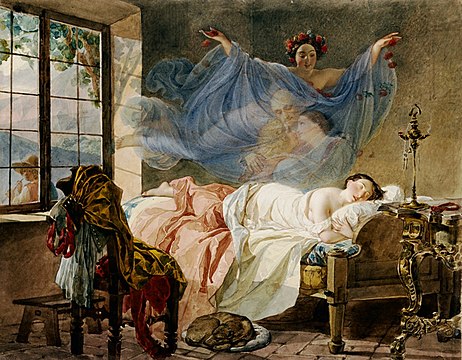Karl Bryullov
Karl Bryullov | |
|---|---|
| Карл Павлович Брюллов | |
 Karl Bryullov, self-portrait, oil on cardboard, 1848. Tretiakov Gallery, Moscow | |
| Born | Charles Bruleau December 12, 1799 |
| Died | June 11, 1852 (aged 52) |
| Resting place | Cimitero Acattolico |
| Nationality | Russian |
| Education | Professor by rank (1836) |
| Alma mater | Imperial Academy of Arts (1821) |
| Known for | Engraving, Painting |
| Movement | Romantic; Orientalist |
| Awards | |
Karl Pavlovich Bryullov (Russian: Карл Па́влович Брюлло́в; 12 December 1799 – 11 June 1852), original name Charles Bruleau,[1] also transliterated Briullov and Briuloff, and referred to by his friends as "Karl the Great",[2][3] was a Russian painter. He is regarded as a key figure in transition from the Russian neoclassicism to romanticism.
Biography
Karl Bryullov was born on December, 12th (23), 1799 in St. Petersburg,[1] in the family of the academician, woodcarver, and engraver Pavel Ivanovich Briullo (Brulleau, 1760—1833) who was of Huguenot descent. He felt drawn to Italy from his early years. Despite his education at the Imperial Academy of Arts (1809–1821), Bryullov never fully embraced the classical style taught by his mentors and promoted by his brother, Alexander Bryullov. After distinguishing himself as a promising and imaginative student and finishing his education, he left Russia for Rome where he worked until 1835 as a portraitist and genre painter, though his fame as an artist came when he began doing historical painting.
His best-known work, The Last Day of Pompeii (1830–1833), is a vast composition compared by Pushkin and Gogol to the best works of Rubens and Van Dyck. It created a sensation in Italy and established Bryullov as one of the finest European painters of his day. After completing this work, he triumphantly returned to the Russian capital, where he made many friends among the aristocracy and intellectual elite and obtained a high post in the Imperial Academy of Arts.
An anecdote concerning Bryullov appeared in Leo Tolstoy's essay "Why Do Men Stupefy Themselves?" and later in the same author's book What Is Art?.
While teaching at the academy (1836–1848) he developed a portrait style which combined a neoclassical simplicity with a romantic tendency that fused well, and his penchant for realism was satisfied with an intriguing level of psychological penetration. While he was working on the plafond of St Isaac's Cathedral, his health suddenly deteriorated. Following advice of his doctors, Bryullov left Russia for Madeira in 1849 and spent the last three years of his life in Italy. He died in the village of Manziana near Rome and is buried at the Cimitero Acattolico there.
Selected artwork
-
Italian Morning, 1823, Kunsthalle Kiel
-
Italian Midday, 1827, Russian Museum
-
Girl, gathering grapes in the vicinity of Naples, 1827, Russian Museum
-
A Dream of a Girl Before a Sunrise, 1830-1833, Pushkin Museum
-
Daughters of Pacini, Giovannina and Amazilia, 1832, Tretyakov Gallery
-
Portrait of Sophia Andreevna Bobrinskaya (Shuvalova), 1849.
See also
References and notes
- ^ a b Karl Pavlovich Bryullov at the Encyclopædia Britannica
- ^ An allusion on Charles the Great
- ^ Agnieszka Świętosławska (2015). "Emigration as an artistic turning point – Ignacy Szczedrowski, Konstanty Kukiewicz and Tadeusz Gorecki at the Imperial Academy of Arts in Saint Petersburg". Art Inquiry (17). Łódzkie Towarzystwo Naukowe: 321–345.
Literature
- С. Н. Кондаков (1915). Юбилейный справочник Императорской Академии художеств. 1764-1914 (in Russian). Vol. 2. p. 25.
External links
- Paintings by Bryullov Karl - high res
- Online gallery of Briullov paintings
- Brullov's paintings at the Russian Art Gallery
- Karl Brulloff. The Last Day of Pompeii
- Academic staff of the Imperial Academy of Arts
- Imperial Academy of Arts alumni
- Awarded with a large gold medal of the Academy of Arts
- 1799 births
- 1852 deaths
- Orientalist painters
- Painters from Saint Petersburg
- Russian neoclassical painters
- Russian romantic painters
- Russian people of French descent
- Russian people of German descent
- Burials in the Protestant Cemetery, Rome







